Groundcovers are low-to-the-ground plants that you can use to help fill out your landscape. Keep reading to learn about some groundcover plants that require minimal watering and care in Sarasota County.
Note: The following information is adapted from the Florida-Friendly Landscaping™ Plant Guide.
Legend
Apart from the information presented in the table, the following features will be highlighted under each plant’s picture.
Light
 : At least 6 hours of full sun
: At least 6 hours of full sun
 : 2-4 hours of full sun per day
: 2-4 hours of full sun per day
 : Full shade
: Full shade
Perks
 : Attracts pollinators
: Attracts pollinators
 : Attracts birds
: Attracts birds
 : Edible parts*
: Edible parts*
Geography
 : Native
: Native
 : Non-native, Florida-friendly
: Non-native, Florida-friendly
Groundcovers
Ice plant (Carpobrotus edulis)
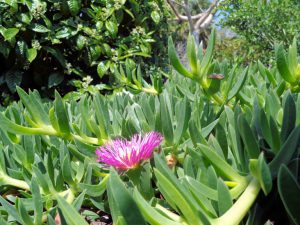




| Height | 3 to 6 inches |
| Growth Rate | Fast |
| Hardiness | 7B to 11 |
| Light Requirement | Full sun |
| Salt Tolerance | High |
| Drought Tolerance | High |
| Soil Preference | Slightly acidic to slightly alkaline (6.0-7.2), sandy, well-drained |
| Comments |
|
Read more here.
Frogfruit (Phyla nodiflora)
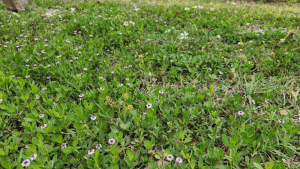




| Height | 1 to 6 inches |
| Growth Rate | Moderate |
| Hardiness | 8A to 11 |
| Light Requirement | Full to partial sun |
| Salt Tolerance | Low |
| Drought Tolerance | Medium |
| Soil Preference | Tolerates wide range of soil pH (4.5-8.0), medium to well-drained |
| Comments |
|
Read more here.
Sunshine mimosa (Mimosa strigillosa)
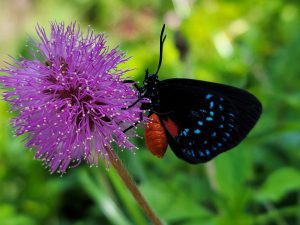



| Height | 3 to 8 inches |
| Growth Rate | Fast |
| Hardiness | 8A to 11 |
| Light Requirement | Full sun |
| Salt Tolerance | Medium |
| Drought Tolerance | Medium |
| Soil Preference | Acidic to slightly alkaline (4.5-7.2), well-drained |
| Comments |
|
Read more here. Quick hits video here.
Perennial peanut (Arachis glabrata)
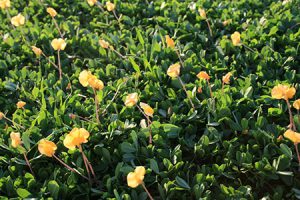




| Height | 3 to 8 inches |
| Growth Rate | Fast |
| Hardiness | 8B to 11 |
| Light Requirement | Full sun |
| Salt Tolerance | High |
| Drought Tolerance | High |
| Soil Preference | Slightly acidic to slightly alkaline (6.0-7.2), sandy clay, well-drained |
| Comments |
|
Read more here. Quick hits video here.
Asiatic jasmine (Trachelospermum asiaticum)
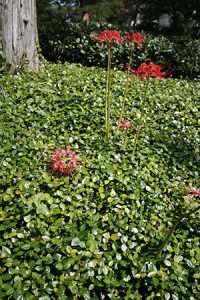




| Height | 6 to 8 inches |
| Growth Rate | Fast |
| Hardiness | 8A to 11 |
| Light Requirement | Full sun to full shade |
| Salt Tolerance | Medium |
| Drought Tolerance | Medium |
| Soil Preference | Tolerates wide range of soil pH (4.5-8.0), medium to well-drained |
| Comments |
|
Read more here.
Dwarf mondo grass (Ophiopogon japonicus)




| Height | 2 to 6 inches |
| Growth Rate | Slow |
| Hardiness | 7A to 11 |
| Light Requirement | Partial sun to full shade |
| Salt Tolerance | Medium |
| Drought Tolerance | Medium |
| Soil Preference | Slightly acidic to slightly alkaline (6.0-7.2), well-drained |
| Comments |
|
Read more here.
Bahiagrass (Paspalum notatum Flugge)
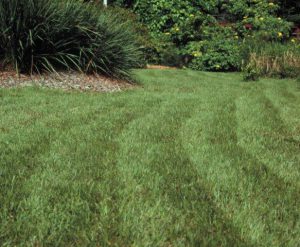


| Height | 3 to 4 inches |
| Growth Rate | Moderate |
| Hardiness | 7A to 11 |
| Light Requirement | Full sun |
| Salt Tolerance | Low |
| Drought Tolerance | High |
| Soil Preference | Slightly acidic (5.0-6.5), medium to well-drained |
| Comments |
|
Read more here.
Mixed-mowable lawn
Finally, nothing is more low-maintenance than a mixed-mowable lawn. Embracing a mixture of the above groundcovers and more that are covered in the Lawn Ornament Blog Series in the Right Places will lead to a low-maintenance, eco-friendly lawn. You will utilize less chemicals, use less irrigation, and provide for local wildlife, all while having a visually striking lawn.

If you want to learn about other low-maintenance plants for your landscape, read the rest of our Low-Maintenance Landscaping blog series.
*Although we discuss edibility in this blog, UF/IFAS Extension Sarasota County is not responsible for any illness or injury associated with foraging. Be aware that some plants may have been treated with pesticides and are not fit for human consumption. Always exercise caution.
 6
6
